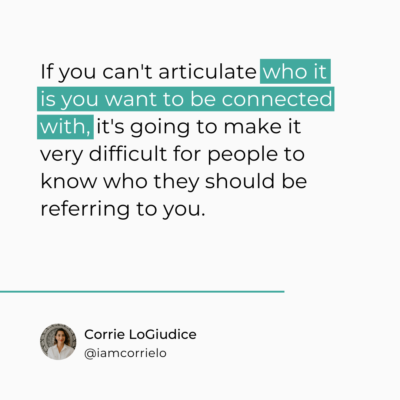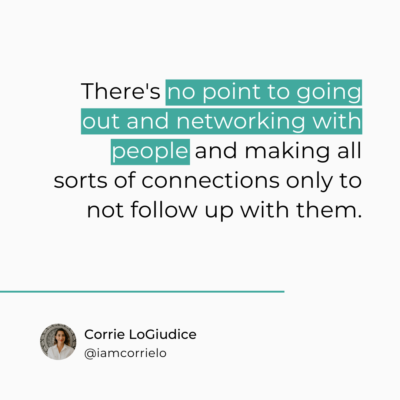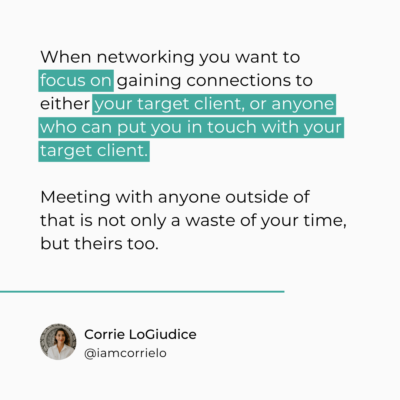Want to build connections and create endless opportunities for your business? Learn how to network by avoiding these networking mistakes.
Many people find networking intimidating, and for a reason: no one wants to make a bad impression!
But networking is still one of the best ways to build relationships that can lead to significant business opportunities – and as a business owner, I’m sure you don’t want to miss out on those.
In this blog post, I’m going to discuss how you can avoid the most common networking mistakes so you, with a little bit of practice and preparation, can get more results from your time and effort.
So, let’s get started.
Mistake 1 – Not knowing who you want to network with.
Any type of networking can only be successful if you have a clear idea of who you wish to connect with.
Because here’s the thing, if you’re not clear about who you’re networking with, you could end up wasting time talking to people who aren’t interested in what you have to say. Without clarity of who you would like to reach out to, it would be difficult for you to craft a compelling message that hits the sweet spot.
After all, how would you even know about their problems if you don’t know who they are?
Besides, how can your family, friends, and acquaintances refer you to others if you, yourself, don’t know who you should be reaching out to?
That’s why, I always say, and it bears repeating, that when networking, you need to have clarity in place before going out there and making connections.
If at this point, you’re still unsure about who you’d like to target, then this video might help you figure it out.

Mistake 2 – Not having a clear and concise positioning statement.
Another thing that can hinder your success in networking is not having a clear and concise positioning statement.
A positioning statement simply describes who you are, what you offer, and what value you bring to the table. It also helps potential clients understand what makes you unique and different than other businesses in your industry and why they should care about you.
In other words, a positioning statement is your elevator pitch.
But the thing is, if you do not have this information put together in a very easy, repeatable scripted phrase that you can use over and over again in every networking meeting, then:
- You might have difficulty articulating what it is that you really do.
- People may not pay attention or even remember what you said to them;
- It will be tough for you to create a lasting impression on your prospects.
And lastly, it’s also important to note that a positioning statement does not mean you need to write an entire book-length document. In fact, it should be the other way around: clear, concise and hits the nail right on the head.
Mistake 3 – Not asking for other people’s contact information.
When you go out there and start networking, you need to put in mind that collecting information is one of the primary objectives of networking. Because if you don’t ask for someone’s contact info, you won’t be able to reconnect with them later.
So, make sure you collect everyone’s contact information in a very efficient and organized manner.
Ask for their business cards. Take notes if you need to.
The point is, don’t just take a passive stance, especially during networking events. Be proactive and take steps to reach out to people. Pay attention and remember who you meet and speak with. And you’ll want to make sure you save those contacts’ information so you can follow up later.
When you are proactive in gathering information during any networking event, you are intentional about the connections you make, which then empowers you to maximize your time and effort.
Mistake 4 – Not following up with your new connections.
If you’ve been diligently networking, then you know how valuable it is to follow up. After all, you need to let your prospects know (and help them remember) that you’re in the business to help people like them.
Following up could be as simple as sending a quick email thanking them for their time, mentioning something you learned from them or sharing some news about yourself.
Doing so will allow you and your brand to stay top of mind when the time comes for them to think about hiring you or referring you to others.
If you skip the follow-ups, you could miss out on an opportunity to build relationships with prospects and even establish yourself as a trusted resource. So, make sure you stay connected and follow up with people you meet. Even if you don’t end up working with them, they might still be able to refer you to another prospect.

Mistake 5 – Hopping on a call with everybody.
Now, I understand that sometimes it’s too tempting to hop on a one-on-one call with just about anybody you’ve spoken to at a networking event. But, before you jump into a phone conversation, consider this: how can a one-on-one talk with a specific person contribute to your overall strategy?
For instance, if you have a goal of getting more clients, it makes sense to focus on the people who fit your ideal client profile. Don’t spread yourself out too thinly by hopping on one-on-one calls with people who will not help you grow your business.
Because here’s the thing: talking with just about anybody over the phone won’t serve anybody. It’s like throwing spaghetti on the wall and seeing what sticks. Sure, you may get lucky and connect with somebody who can help you, but that rarely happens. More often than not, hopping a call with everybody would just waste everybody’s time.
What you can do, though, is to pick out some specific individuals who you feel would be a good fit for your business. They could either be your direct target clients or individuals who might be able to put you in touch with direct target clients. Then, set aside enough time to talk to them on the phone or in person.
Mistake 6 – Hopping on a one-on-one call but not having a set agenda.
Another huge time-waster you need to avoid is making calls without a set agenda.
Because let’s face it: nobody has the time to waste just to hop on a call and talk without a clear purpose.
So, instead of calling every single person you spoke to at a networking event, first decide which ones you want to reach out to. Then, plan your approach accordingly. What would you like to discuss with them so both of you can move forward?
Then, once you’ve got all this planned out, you’ll know exactly what you need to say and how you need to say it. This way, you’ll be able to keep things short and sweet while still being able to convey your message effectively.
Remember, in networking, you need to be strategic in everything you do, including making one-on-one contacts. So, when you’re planning out your next step, think about how you can best leverage the connections you made at the last networking event.

Mistake 7 – Attempting to sell on the one-on-one call.
If there’s anything you must avoid doing at all costs is this: trying to sell products or services during one-on-one calls. Unfortunately, I still see a lot of people doing this.
You see, one-on-one calls are supposed to give you an avenue to connect – to learn about the person and figure out how you can best help and serve them through leveraging your network. In other words, the goal here is to get to know your prospects a little bit better and decide whether or not you should take things to the next level.
So, do yourself a favor. Don’t be like other folks who use one-on-one calls as an opportunity to sell or deliver a one-sided sales pitch.
As somebody who’s ever been on the receiving end of one of these calls, let’s just say that it doesn’t feel very good when you’re expecting one thing and then you’re delivered a sales pitch right off the bat. It’s inauthentic, sleazy, and even kind of sneaky at times, too. And if you do the same thing to your prospects, there’s a massive chance that they’ll feel the same way, too, and they might be turned off from working with you altogether.
Instead, book sales calls separately from your one-on-one calls. You will have an opportunity to sell down the line if the person you’re speaking to during the one-on-one call fits your ideal customer profile. But, until then, focus on building rapport and getting to know your prospect a little more before moving into selling mode.
In Summary
Networking can be tough, especially when you’re new to it. But, if you don’t put in the effort now, you won’t reap any rewards later.
So, if you want to build lasting relationships and business opportunities, you need to start putting in some serious networking hours and save some time and effort by avoiding the mistakes above.
And remember, the key to success is always being authentic and genuine. That means being honest about who you are and what you offer. It also means making sure you only work with those who share the same values as you.
Lastly, if you ever find yourself stuck while networking to grow your new business, you’re welcome to schedule a call with me. There’s no obligation to work with me and I’m here to help!
Click here to schedule a call.
Until next time! Thanks for reading this quick guide on how to network.


